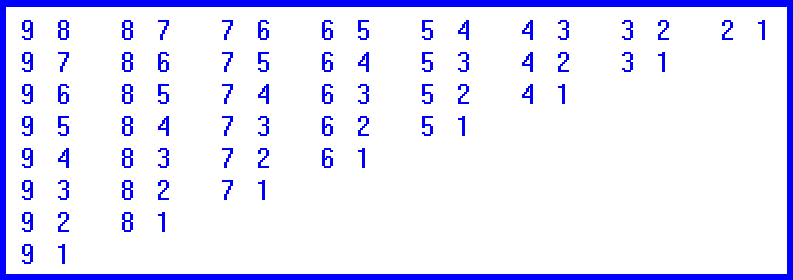Puzzle #56
You have a bank account which pays 5% interest. You make only 1 deposit and no withdrawals. After how many years will the amount of money double?
Basically, this is asking, if you deposit $100 into an account that pays 5% annual interest, how long will it take for this to become $200?
Puzzle #55
In the United States Supreme Court, there are 9 justices. Each day, when they assemble, before going on the bench, they shake hands with each other.
How many handshakes occur?
Puzzle #54 09/01/2003
This probability puzzle has been around a long time. Generally, it is referred to as the Monty Hall Problem because it is somewhat based on a show he hosted called “Let’s Make A Deal”. The problem is stated as follows.
You are a contestant on “Let’s Make A Deal” and you have been shown three doors. You are told that behind one of the doors, is a new car, and behind each of the other two doors is a goat. Naturally, you want to win the car and you are told you can pick any one of the three doors. This would mean your chance of winning the car based on this condition is one in three or one third.
However, after you make your pick, Monty Hall opens a door you haven’t chosen and shows that it’s a goat. He then offers to let you change your selection. Would changing your selection decrease your odds of winning the car, increase your odds or make no difference whatsoever?
It might be a little easier to use an actual example.
You pick door number one.
Monty Hall shows that a goat is behind door number two.
He then offers you the choice of picking door number three or you can stay with your original choice of door number one.
Should you change your pick to door number three, stay with door number one or does it make any difference?
Conditions in effect when playing this game:
The placement of the car and the goats is done totally at random and you have no way of knowing what is behind which door.
Monty Hall knows exactly where all three are.
After you make your pick and Monty Hall shows you one of the other doors, it will always be a “goat” door and he will not show the “car” door nor will he open up the door you just chose.
Puzzle #53 07/01/2003
![chsboard[1]](https://wp.1728.org/wp-content/uploads/2024/02/chsboard1.gif)
The above graphic shows a chessboard that has had its upper left square and its lower right square “sawed off”. Underneath that is a domino that is exactly the size of 2 of the chessboard squares. If you had 31 of these dominoes, would you be able to arrange them so that ALL 62 squares were covered ?
Puzzle #52 06/01/2003
Let’s assume that a $20 gold piece weighs twice as much as a $10 gold piece. So, which would you rather have, a half pound of $20 gold pieces or a pound of $10 gold pieces?
Puzzle #51 05/01/2003
An airplane pilot overheard a woman say that she had missed her flight. The pilot said “I can give you a ride and I’ll charge you nothing because you won’t even be taking me out of my way.” The woman was very suspicious of this offer especially when she said “But you don’t even know where I’m going !!” The pilot said “It doesn’t matter. It will not be out of my way.” The pilot was not lying so just where the heck was he going?
Puzzle #50 3/1/2003
How about an easy puzzle this month? A class consists of 58% girls and 42% boys. There are 6 more girls than boys in the class. How many TOTAL students are there?
Puzzle #49 2/1/2003
You are offered an even-money bet involving the flipping of two coins.
You have 2 chances to flip 2 coins and if you get two heads in either flip, you win.
For each flip of the two coins there are 4 possible outcomes:
Is your reasoning correct ?
Puzzle #48 1/1/2003
When rolling 2 six-sided dice, there are 36 possible combinations. Out of these 36 combinations, there is only one way that a twelve (2 sixes) can appear.
You are offered an even-money bet (let’s say for $10) that if you can throw a twelve in 21 throws, you win $10. If not, you lose $10. Also, you may continue to make bets for as long as you’d like.
You reason that a twelve is 1 out of the 36 dice combinations, therefore your chances are 50-50 after 18 rolls and with 21 tries you are going to come out a winner more often than not. Is this reasoning correct?
